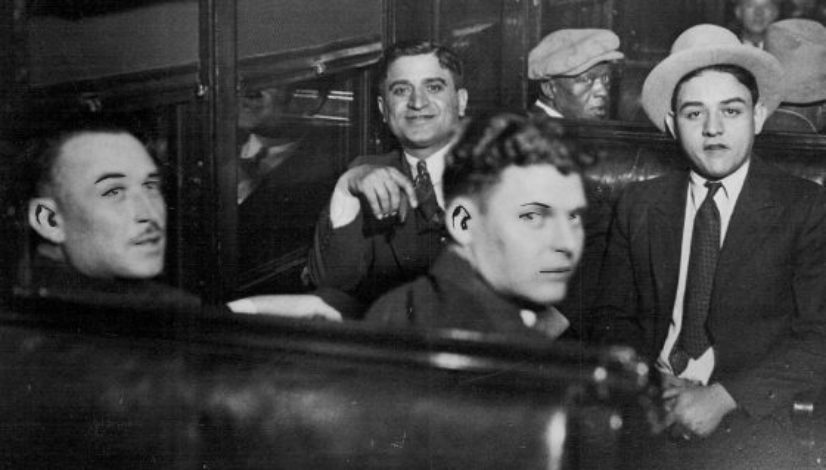Prohibitionist Post: 125 years covering Colorado’s love-hate affair with alcohol and cannabis

Published: Oct 16, 2017, 7:09 am • Updated: Oct 16, 2017, 12:36 pm
By Alex Pasquariello, The Cannabist Staff
Denver has long been a premier spot for getting wasted.
Back in 1859, the Denver City was founded when land speculators led by Gen. William Larimer persuaded a competing mining claim to surrender its rights with a barrel of whiskey. The first city government was subsequently formed in a saloon. Over the next decades, a silver boom – and the arrival of the railroad – transformed the town into a frontier watering hole as prospectors and immigrants flocked to the foot of the Rocky Mountains to soak in sorrows and toast good fortune.
By the turn of the 20th century, the city’s unruly reputation thrust the nascent state of Colorado into a love-hate relationship with prohibition that is still being realized to this day. And for nearly every step, The Denver Post has been there to cover the complicated affair.
As the state rounded the bend into the 20th century, the temperance movement was well under way in the West, frothing up fear of a liquor-fueled uprising by European-immigrant miners. The zeitgeist was summarized in a September 1914 Post story on a gathering of Denver’s People’s Tabernackle. During the rally, William A. “Billy” Sunday called for a ban on alcohol and railed against the city’s “whiskey-soaked, foul-mouthed, vermin covered, pug-gut, hog-jowled, weasel-eyed” drinkers.
Less than two months later, Coloradans voted for prohibition. When the law went into effect Jan. 1, 1916, The Post was there to set the mood: “Denver Drinks Health of New Year in Lemonade as Joy Liquids Vanish.” Deeper in the paper, follow-up stories reported, “Disorder and trouble fail to materialize in Larimer Street” and “Revelers fill cafes and try hard to be real devilish.”
Colorado’s prohibition – enacted more than four years before national Prohibition would take hold – shuttered about 1,500 saloons and 500 hotels and restaurants, according to Post legend Dick Kreck’s July 2009 opus, “High, dry times as Prohibition era sobered Denver.” The first drunk arrested New Year’s Day, Kreck found, was a point of contention between The Post and competitor Rocky Mountain News. While The Post reported 49-year-old laborer John Hanson was the first, the News gave the honor to 38-year-old farmer Charles Robbins.
Prohibition had the full-throated support of The Post, but the paper didn’t dilute coverage of its effects – thousands of residents living in open rebellion of state and federal authority.
The Post covered smuggling with gusto. In February 1916, the paper reported that up to $3,500 worth of beer and liquors were flowing into Colorado from Wyoming each month. A month later, a piece reported on the confiscation of cider shipped to 11 Denver merchants by the Los Angeles Fruit Products Company of St. Louis. In January – as the state was preparing to ratify federal Prohibition – a front-page story outlined a spoiled plot to smuggle thousands of pints of whiskey into Denver disguised as olive oil.
Reporting on Coloradans’ imaginative, if not dangerous and unsanitary, distilling operations also sold papers. In February 1920, a Post headline warned: “Sulphuric Acid and Water are Sold as Whiskey to Denver Clubmen and Alleged Bootleggers are Jailed.” It went on to describe booze that “smokes like a cigar.” In October 1921, The Post discovered dead rodents inside liquor stills run at local dairy. A January 1922 story described, with some admiration, a still that a Denver mechanic built out of old gas tanks and exhaust pipes.
Related stories
- Election 2016 a watershed moment for marijuana prohibition & legalization
- Prop 64: Why so much of California’s cannabis industry isn’t ready for legalization
- Across America, efforts to decriminalize marijuana are pitting cities vs. states
- Why marijuana legalization vote in California may herald end of prohibition era
- ‘There’s 3 million drug addicts, I’d be happy to slaughter them’: Philippines drug war has turned into genocide
By 1925, The Post could tell which way the wind was blowing, Kreck reported. In an editorial calling for a national referendum on the issue, the paper declared: “The longer Prohibition goes the more apparent it becomes that no law ever passed in this country has been so flouted and treated with contempt and contumely. … We ought to get honest about booze again.”
Colorado ratified the 21st Amendment repealing Prohibition on Sept. 26, 1933. The Post’s story was succinct – just barely above the fold – and observed: “Wets’ new responsibility accented.”
Was The Post predicting a future wherein a Colorado governor who made his fame and fortune as a beer brewer would preside over the end of marijuana prohibition?
Alcohol prohibition was dubbed “The Noble Experiment,” and current Colorado Gov. John Hickenlooper has been quoted in The Post describing marijuana legalization as “A Great Experiment.”
But Colorado was a laboratory for regulating marijuana a full 95 years before Colorado voters legalized recreational marijuana with the passage of Amendment 64. A 1917 measure making the growing and selling of the plant a misdemeanor doesn’t appear to have garnered major coverage. However, with alcohol banned, marijuana – née marihuana – and the Mexican immigrants blamed for it sparked hysteria throughout the American West, and Post reporting fanned the fire.
In April 1929, the gruesome murder of a white child by her Mexican stepfather gripped the pages of The Post: “Father Beats Child to Death With Poker,” “Posses Hunt Man Who Beat Child to Death,” “Fiend Slayer Caught in Nebraska; Mexican Confess Torture of American Baby.” The subhead to that story read: “Prisoner Admits to Officer He Is Marijuana Addict.” The Colorado Assembly didn’t wait for a trial to act — by the end of the 1929 legislative session, the body had passed and the governor signed a bill making repeat marijuana offenses a felony.
The feds caught up to Colorado in 1937 when the Marihuana Tax Act went into effect Oct. 1. Days later, Denver resident Samuel Caldwell was the first person arrested for a federal marijuana charge. Under the slug “CRIME NEVER PAYS,” the lede in The Post’s Oct. 8, 1937, story declared: “The government proved Friday it means business in its drive against the peddlers and users of marijuana.”
More illuminating to the racist, sensationalist coverage of marijuana common during the day, however, was a subsequent story, “Arrest of Four Aliens Reveals Denver Marijuana Sales Ring,” which reported that it took four officers to subdue stoned suspect Juan Moya, who managed to eat most of his stash in the process.
It was among a slew of Post stories that would fill the infamous “Gore Files” of Federal Bureau of Narcotics chief Harry J. Anslinger, the man who led cannabis prohibition at the national level until 1962.
Is the journalistic past prologue?
The Post prohibitionist predilections put it on the wrong side of Colorado’s major voter-led legalization efforts, 2000’s Amendment 20 legalizing medical marijuana and 2012’s Amendment 64 legalizing the sale of recreational marijuana.
“We think the risks are not worth the potential benefits,” an Oct. 12, 2012, editorial said of Amendment 64. “If Colorado becomes an island with legal marijuana, what’s to prevent it from also becoming a magnet nationally for marijuana users, growers and distributors?” With sales of cannabis in Colorado topping $1.3 billion in 2016, it appears the answer – short of federal legalization — is nothing.
Denver was on the cusp of legalization in December 2013 when the paper launched The Cannabist, its most ambitious digital – and perhaps journalistic – venture to date. In a matter of three years, founding editor Ricardo Baca grew the website into an influential, multichannel national news and lifestyle website on the vanguard of #AllThingsWeed.
“We weren’t really the first, but I think we were the first to throw these kinds of resources and approach it from a perspective of journalism, not activism,” he told the Poynter Institute’s Benjamin Mullin.
The Post has also moved to get its piece of the pot pie, having recently wrapped a Sunday issue in an advertisement for a cannabis company; the industry now advertises regularly on The Cannabist.
But some things never change: Cannabis remains federally illegal – now under the guise of the Controlled Substances Act of 1970, which counts marijuana as a substance as dangerous as heroin and LSD, and the Drug Enforcement Agency still spells it “marihuana.” Law enforcement authorities also continue to cite The Post’s reporting in efforts to fortify national prohibition. In a May 1 letter to congressional leaders, U.S. Attorney General Jeff Sessions requested renewed authority to crack down on medical marijuana in states that have legalized it, citing The Post’s March coverage of a massive black-market bust in which half the suspects had state-issued licenses to grow the plant.
The attorney general has yet to cite in writing The Post’s 2015 Pulitzer Prize finalist, “Desperate Journey,” which followed the plight of a North Carolina family who moved to Colorado in order to treat a sick child with cannabidiol, a cannabis compound touted for its medicinal promise.
Nearly four full years into the post-prohibition era, cannabis is a commodity unlike any the state has seen before. It is simultaneously life-saving medicine to some and the life of the party, a spiritual sacrament and an economic engine to others. The Post’s coverage of the first day of legal recreational marijuana sales in the state foreshadowed that future. The first Coloradan to make a purchase on Jan. 1, 2014, Post staff writer John Ingold reported, was 32-year-old Iraq war veteran Sean Azzariti. He told the paper he used cannabis to alleviate symptoms of post-traumatic stress disorder.
The 2016 stories for which Post and Cannabist journalists were recently recognized by the Colorado Press Association further reflect the extent to which marijuana is the most dynamic beat in journalism today.
Last year, The Cannabist’s Alicia Wallace received a first-place award for Best Agriculture Story for “How one of America’s most visible Fortune 1000 giants (Miracle Grow) snuck into the cannabis industry” and first place Best Business News/Feature Story for “Slow to rebound, Pueblo is redefining its economic image.” She also received second-place recognition for Best Health Enterprise/Health Feature Story for “How PTSD became the most divisive pot issue of 2016.” The Post’s Ingold and Jesse Paul received second-place honors for Best Deadline News Reporting for their story “Colorado town finds THC in its water, warns residents not to drink or bathe in it.” Sports reporter Nicki Jhabvala won first place for Best Series for “Game of Pain,” which covered NFL athletes’ use of CBD.”
What does it all portend for the next century of Post journalism? The ever-shifting landscape of legal cannabis makes it hard to plan the upcoming week’s coverage, let alone predict how Colorado’s experiment will unfold. As The Post’s coverage of Colorado’s complicated affair with prohibition shows, the paper will be a critical variable in the laboratory as the state continues with one of the greatest experiments American democracy has known.
Topics: Colorado, Denver, history, prohibition  Alex Pasquariello
Alex Pasquariello
Alex joined The Cannabist as Editor in April 2017. He started his journalism career in Colorado as a reporter at community newspapers and national ski magazines before heading to New York to work as an editor at Condé Nast Traveler and digital…




